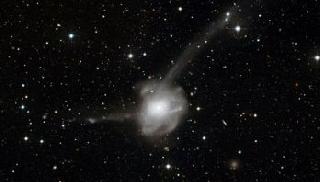
This new image shows the results of a vast collision between two galaxies. An ESO photo
PARIS (BNS): A galactic collision around 220 light-years away in the constellation of Aquarius has caught the attention of astronomers.
‘Atoms-for-Peace’, also called NGC 7252, is a ‘galactic pile-up’ resulting out of the collision and merger of two galaxies.
The galaxy appears as a very faint small fuzzy blob. Its images, acquired by ESO’s Wide Field Imager on the MPG/ESO 2.2-metre telescope at European Southern Observatory’s La Silla Observatory in Chile, show the “chaos of collision” in full flow.
“The results of the intricate interplay of gravitational interactions can be seen in the shapes of the tails made from streams of stars, gas and dust. The image also shows the incredible shells that formed as gas and stars were ripped out of the colliding galaxies and wrapped around their joint core,” according to ESO.
During the collision, while much material was ejected into space, other regions were compressed, sparking bursts of star formation. The result was the formation of hundreds of very young star clusters, around 50 to 500 million years old, which are speculated to be the progenitors of globular clusters.
The ‘Atoms-for-Peace’, according to astronomers, may be a harbinger of our very own galaxy Milky Way’s fate. They predict that in three to four billion years, the Milky Way and the Andromeda Galaxy will collide, in a similar way like the Atoms-for-Peace.
However, this collision will not pose any threat as it is unlikely that our Sun will end up in a head-on collision with another star during the merger, they say.
The new image of ‘Atoms-for-Peace’ is expected to help astronomers understand how mergers affect the evolution of the Universe.
 Previous Article
Previous Article













The Indian Air Force, in its flight trials evaluation report submitted before the Defence Ministry l..
view articleAn insight into the Medium Multi-Role Combat Aircraft competition...
view articleSky enthusiasts can now spot the International Space Station (ISS) commanded by Indian-American astr..
view article